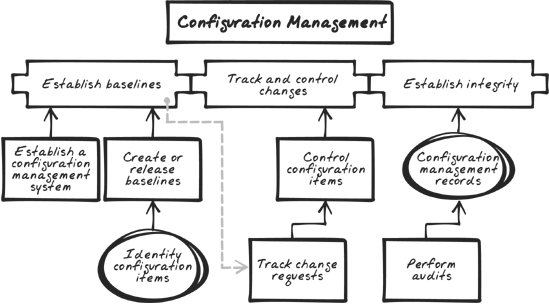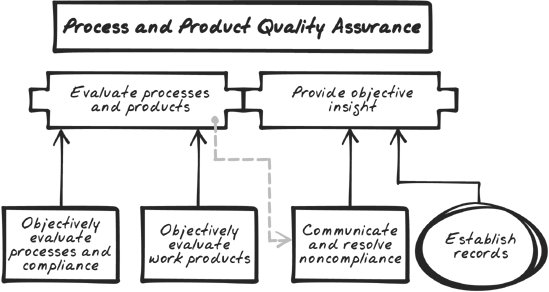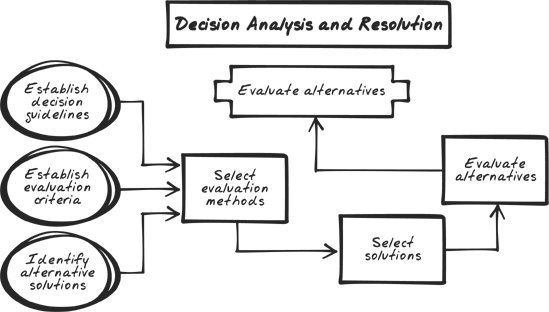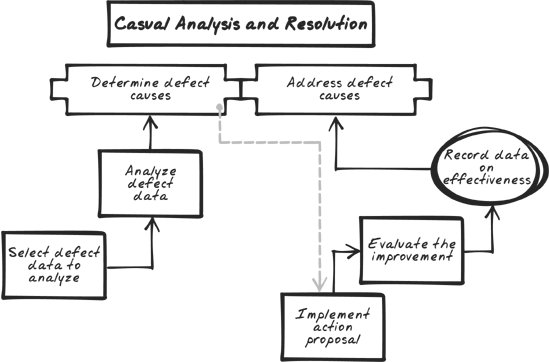Section 6.9. Support Process Areas
6.9. Support Process AreasThe following sections detail the Process Areas specific to support. 6.9.1. Configuration ManagementThe role of Configuration Management in CMMI covers two areas: technical configuration management and change control. Configuration Management is a discipline designed to ensure the integrity of the work products that impact project success. In the realm of systems and software development, this most often includes configuration management of source code, code compilers, and key technical documentation. But in mature organizations, this usually expands to include other items as well. Often you'll find that it's beneficial to configuration-manage such products as the requirements specification, system designs, test plans, and even such management items as the Project Plan. The scope of Configuration Management naturally depends upon the scope of your project. But whether you elect basic or comprehensive configuration management, the practices remain the same. The other focus is change control. As change is a natural component of any project, it is important that the organization set into place some form of change management. A basic change-control program typically includes such elements as a change-control process (for introducing and assessing change requests), some manner of change-management system, and a change-management body such as a change-control board. Both these facetsversion control of configured items and change managementserve as support arms for project management. They provide for the incorporation and coordination of change over a project's progression across time. 6.9.1.1. Three specific goalsCMMI presents three goals for Configuration Management:
6.9.1.2. Core Configuration Management actionsThe configuration manager monitors and controls a defined set of project work products through a Configuration Management system by creating baselines, tracking changes, and periodically reporting on the integrity of designated work products. Applies to Support:
Figure 6-13 illustrates the Configuration Management PA. Figure 6-13. The purpose of Configuration Management is to control the integrity of a work product across the life of the project. This includes practices in three areas. First, the team establishes a Configuration Management system it can use to control and release baselines. Second, the team sets change-control mechanisms in place to track and analyze change requests. Third, the team periodically audits the contents of the Configuration Management system to ensure work product integrity. 6.9.2. Process and Product Quality AssuranceThe PPQA Process Area in CMMI is the model's core compliance component. Process and Product Quality Assurance is in many ways kin to Configuration Management. Its function is to ensure the integrity of a project's work products and processes from a standards viewpoint. A PPQA analyst[*] assigned to a project monitors two operational areas. First, the analyst is responsible for work product compliance. Key here is confirming that selected work products produced during the various phases of a project are created in accordance with established formats, content guides, and scope projections. Second, the analyst is responsible for process compliance. This involves the work activities on a project. The goal here is to confirm that the major work activities for a project are conducted in compliance with published process standards.
The chief tool of PPQA is the audit. Through the use of a PPQA Plan, the PPQA analyst identifies certain milestone points in the project where product and process audits should take place. The audits are then conducted against a checklist of compliance items, and the results of the audit are distributed to project managers, identified team members, and executive management. As noted earlier, this PA is also related to Verification. But it differs in one key way. Verification contains a peer-review process conducted by team members reporting to project management. PPQA is an activity typically managed by a function that reports to executive management in addition to project management. The main job of the PPQA analyst is to provide objective evidence that project teams within the organization at large are conducting project activities according to established processes. 6.9.2.1. Two specific goalsTwo goals are defined for Process and Product Quality Assurance:
6.9.2.2. Core Process and Product Quality Assurance actionsA Process and Product Quality Assurance analyst, using objective criteria, works with the project team to audit activities and work products to make sure that they are being conducted in a manner compliant with published processes, procedures, and standards. Applies to Support:
Figure 6-14 illustrates the Process and Product Quality Assurance PA. Figure 6-14. Process and Product Quality Assurance is often seen as the process-oversight arm of a project effort. The focus is on ensuring that the project team is following defined processes and is producing appropriate work products in line with standards. Regular audits are planned and conducted, results are communicated, and noncompliance issues are managed to closure. 6.9.3. Measurement and AnalysisThe Measurement and Analysis Process Area presents the foundation for quantitative analysis (and process growth) within project management and across the organization as a whole. As it is introduced here, this Process Area need not be thought of as a full-blown metrics program. Measurement and Analysis may begin small and then lead to a fuller metrics approach to process improvement and program management. Here, each project (coordinated mainly through Project Management, Configuration Management, and Process and Product Quality Assurance) defines a set of measurements that will be collected at various points during the life of a project. These measurements are then incorporated into an M&A plan that specifies how the data will be collected, who will collect it, where the data will be stored, and how it will be used. The main objective of this Process Area is to create a metrics repositorya central database for measurement storage. In the short term, this data can be analyzed as a way to measure variance, as an early indicator of project trends, and as a numeric mechanism to compare projects. In the long term, the repository will serve as a base for establishing quantitative project management measurements and for studying causal analysis with a view toward defect resolution and prevention. 6.9.3.1. Two specific goalsCMMI defines two goals for Measurement and Analysis:
6.9.3.2. Core Measurement and Analysis actionsMeasurements are identified, defined, and collected for key activities and project phases. Once collected, they are used by project management and executive management to interpret project progress and as a mechanism to quantify project and process improvement as a whole. Applies to Support:
Figure 6-15 illustrates the Measurement and Analysis PA. Figure 6-15. Measurement and Analysis deals with collecting process and project-performance measures that can eventually be used to help make improvement decisions. The practices here are designed to target meaningful measures, measures that reflect appropriate business objectives. Once defined, the organization specifies how the measures will be collected, how they will be analyzed, where they will be stored, and how measurement results will be communicated. 6.9.4. Decision Analysis and ResolutionThe purpose of Decision Analysis and Resolution is to give teams a path to follow when making major decisions with the potential to impact the course of a project over its life cycle. Such decision making is common to all projects. At issue here is the manner in which decisions are arrived at. In organizations that lack sufficient or mature processes, projects are usually managed by intuition, by the "gut feeling" of the project manager. In this case, the better the project manager, the better the decisions being made. But this approach does not add much stability to an organization's operational capability. A better approach is to provide a team with decision-making guidelines that promote analysis and the evaluation of alternatives. This approach is not designed to eliminate intuition or experience in project management. Its aim is to augment those qualities within a more regulated framework, one that sets methods for establishing alternatives, weighing the viability of alternatives, and selecting alternatives appropriate to the decision at hand. 6.9.4.1. One specific goalCMMI has one goal defined for Decision Analysis and Resolution:
6.9.4.2. Core Decision Analysis and Resolution actionsThe organization provides project teams with a method for evaluating and weighing alternatives as part of the decision-making process. Applies to Support:
Figure 6-16 illustrates the Decision Analysis and Resolution PA. Figure 6-16. Decision Analysis and Resolution is designed to provide project teams with a mechanism to guide critical decision-making. The goal is to identify those kinds of decisions that should move through the DAR process and then provide activities that will encourage the evaluation of alternatives and the selection of appropriate solutions based on objective criteria. 6.9.5. Causal Analysis and ResolutionCausal Analysis and Resolution addresses the issue of defect analysis and prevention. The purpose here is to investigate the potential causes for the occurrence of defects (in processes and products) and then design solutions to remove these causes from current and future project work. This Process Area requires several things of the organization. First, the organization must be adept at defect tracking. This typically involves some formalized process for product inspection (see the Verification Process Area, under "Engineering Process Areas"), as well as procedures for thorough process analysis and in-depth product testing. These procedures should provide the organization with a repository of defect data, sources, and frequencies. Next, the organization should have a method in place (with appropriate resources) to select and investigate a set of priority defects. These defects are analyzed to determine possible causes, and from these possible causes, corrective-action options are defined. Further production investigation is undertaken to verify defect causes, and then appropriate actions are selected to remove the causes. Causal Analysis and Resolution is an ongoing process in an organization. It can be applied to all manner of work products and activities. And it represents a core focus of any advanced process improvement program. Note: This Process Area bears a direct relationship with the DMAIC process in Six Sigma. For more information on this, see Chapter 7. 6.9.5.1. Two specific goalsTwo goals are defined in CMMI for Causal Analysis and Resolution:
Throughout this process, the team records its findings in a repository for future process improvement information. 6.9.5.2. Core Causal Analysis and Resolution actionsThe organization examines sets of defect data to determine likely causes, modifies processes to test potential solutions, and then records the validity and effectiveness of these solutions. Applies to Support:
Figure 6-17 illustrates the Causal Analysis and Resolution PA. Figure 6-17. Causal Analysis and Resolution is a high-maturity Process Area that uses quantitative analysis and statistical analytics to determine the sources of defects in process performance, and then provides guidelines for addressing the removal of those sources.
|
EAN: 2147483647
Pages: 116